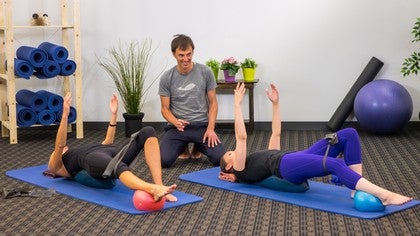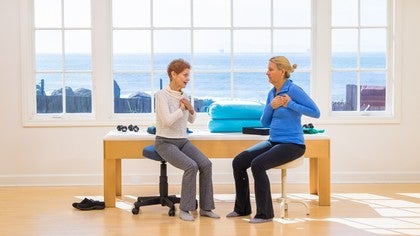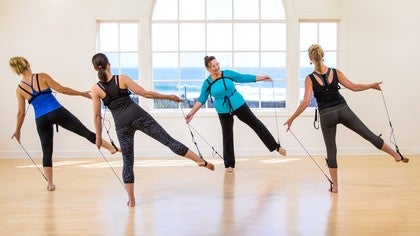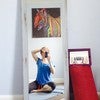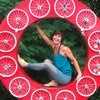Description
About This Video
Transcript
Read Full Transcript
Hi, I'm Daniel Vladeta, and we're going to do a restorative motor control class today with you. This is a great class for anyone who is recovering from any sort of injury, back injury, hip injury, or shoulder injury. It's also fantastic for anyone who's really mobile and needs to learn how to control all of that movement. So what we're going to start, first of all with Gia and Heidi, we're going to position them first, and the other thing we're going to be doing is we're going to be working really, really, really slowly, and this is all about control. So, first of all, we're going to slide our tailbones right down to the end of the oov, and from there coming back, head on the towel, we're going to start everyone off with the towel under their head, hands on your lower ribs, elbows on the ground, and I want one leg up into tabletop, and the other leg up into tabletop.
Now, Gia, your head lifted up. We're gonna take you back down. Anyone who feels their head lift up off the ground, or any strain in their neck, reposition yourself by moving up a little bit higher, coming up into tabletop, and finding the position where, exactly, where you can go into tabletop and not feel anything in your neck or no lifting of your head. So both feet on the ground now. And both arms up in the air, and we're gonna move really, really slowly today, and we're going to start with some arm up, so really slowly moving one arm over the top of your head, and just hold that off the ground.
Don't rest your arms on the ground. So we're gonna keep tension within the system. Coming back, and the other arm off the ground, holding, fantastic, and back, now both arms over the top of your head, and we're just going to hold our arms here for a couple of breaths, and really feel where you breathe from in this position. This is a power pose. This pose has been shown to actually reduce cortisol, increase testosterone, and it also facilitates us to be able to breathe from your diaphragm.
I think you guys can both feel the breath going nice and deep into your abdomen. Coming back up. Now one arm, take your right arm out to the side, and just hold that off the ground. What you're going to feel on the oov is it creates a little bit of torque through your body, so you're having to actually use a little bit more of your core to stabilize here, coming back up, and now the other arm out to the side, and hold, perfect, and coming back up again, so what we're going to do now, we're going to grab our Pilates balls. Let me do this for you.
Now take that ball underneath your right foot, thank you, Heidi, and both arms up above, so we've just added an unstable base under your foot. You can see both of your bodies trying to find balance now, which is great, 'cause we're on an unstable base with an unstable base underneath our foot, and we're having to use our left leg now and our left glute and our left side of our pelvis to stabilize, so taking the right arm over your head, holding that off the ground, coming back, the left arm, fantastic, and back, and now both arms coming back and holding, and take a couple of breaths here for me. And just really slowing that breath out and coming back up with the arms. Now, we're gonna take the opposite arm that our foot's on the ball, so we're gonna take our left arm out to the side for me, and just hold that off the ground, and you're gonna feel how your body's actually really having to find that stability with that extra torque, coming back, and now take your right arm out to the side, and it's hard when that foot's on the ball and that right arm goes out. Holding that there, fantastic, coming back, excellent, and now change feet, so just drop that right foot onto the ground, put that ball underneath your left foot, fantastic, both arms back up over the top, in front of you, and now we're going to go with our left arm over our head, and hold, coming back, and our right arm, hold, coming back, and both arms, holding them just off the ground, take a nice deep breath in.
Fantastic. Each time I can see deeper into your abdomen, just getting that breath, using that diaphragm, and creating space for the diaphragm to work, coming back up with the arms. Now we're going to take our right arm out to the side, holding it just off the ground, and back. Now the left arm out to the side, and hold. Well done, coming back.
Did you feel how one side was easier than the other to use the ball? So we're gonna put the ball back under our right foot, and we've got some thera band underneath the oov. We're going to grab the end of that thera band, we're gonna bring it in on the inside of our elbows, yep, coming on the inside of our elbows, excellent, and coming up in front of us, so now using this band, we're actually upregulating our anterior chain. So we're going to do the same movements again, with some band, so we're going to take one arm over the top, and back, excellent, and the other arm, fantastic, and back. Now we're going to take our left arm out to the side, holding it out there, and back, and our right arm out to the side, holding that out there, really good, coming back.
From here, staying in that position, we're going to roll the ball really slowly straightening our leg all the way out. This is a great gait pattern exercise. It's what we need to do every time we take a step, holding it out there, and then rolling the ball back. We're going to do that two more times. And again, rolling that ball, holding that there, and coming back, and one more, and can you feel your body having to find that stability at all times?
Every time you move that hip, you're having to control that movement plus the stability of your trunk. From here, letting your bent knee fall out, letting your knee fall out to the side. Only go as far as you can control, and coming back, and you're going to find that it takes a lot more control to let that knee fall over. We're doing three of these, controlling that knee out, and coming back, and you might find each time you do it, you get a little bit more movement, and one more, controlling that, holding that out there, and coming back. Well done.
Now we're going to do left arm, right leg. We're going to take that right arm out to the side, and right leg moving out straight for me, please, and hold, and coming back, control that movement. One more, going again, and hold, coming back, and the last thing we're going to do on this side, we're going to do a bent knee fall out, and the left arm going out to the side. Really tough, working that anterior sling. Coming back, and one more.
Holing that out there, great, and coming back. Awesome. Change legs for me. I'm gonna just bring that ball for you. Yep, you got that.
Yep, bring that foot down. Both arms out in front of you again, and we're going to do the same again, so one arm over the top, and coming back, other arm, hold, coming back. We're going to take our right arm out to the side, really slowly, holding that out there, controlling that, and back, and our left arm out to the side, holding, coming back. Now we're going to roll our left leg forward, and lengthening our leg, just pushing into that ball, to give yourself a little bit more stability, if you need to, straightening that leg, holding it there, controlling it, coming back, rolling it back towards you. It's a posterior chain exercise for your leg, and again.
We're gonna do two more. Holding, good, coming back, and one more, holding it out there, fantastic, coming back. Now from here, we're going to do a bent knee fall out. So we're going to let our knee fall out to the side, holding that there, coming back, one more time, holding, only go as far as you can control, coming back, and one more for me, hold, coming back, so now we're going to actually use, roll the left leg forward, and taking the right arm out to the side, so we're going to roll that leg forward, coming out to the side with our right arm, coming back, and one more for me. This is a great cross pattern exercise, and again, hold, coming back.
Now we're going to do a bent knee fall out, letting that left knee fall out and the right arm out to the side. And holding that there, coming back. Only go as far as you can control it. And one more, and good. Control that there, and coming back.
Excellent. Take that foot off the ball. We're going to sit up a little bit and bring that band from underneath us. And coming back down on the oov for me. And this time we're going to do the same movements with the ball under our right foot, but we're going to grab the band in front of us, and we're going to do the same exercises again, but this time we're going to work our posterior chain.
So we worked our anterior chain by pulling up first time, activating our external obliques, and our anterior slings. Now we're pulling on that band and activating more of our lats and our posterior chain, so rolling that ball out. Good, coming back. And again. Excellent.
And back. And one more. Good. And back. So from mere, we're going to take our right arm over the top of our head, coming back on a diagonal, eccentrically loading one sling, activating posterior sling on the other side, coming back, and now our left arm, over the top, excellent.
And coming back. We're gonna take our right arm out to the side, holding that out there, really working that diagonal sling, coming back, and the left arm out to the side for me, fantastic, and coming back. So now we're going to add some ball work. We're gonna roll the ball away, and take our left arm out to the side, rolling that away, hold that out there, coming back, and again. Excellent.
Hold that. Coming back, and we're gonna do a bent knee fall out, first of all without the arms, so letting that knee falling out, good. And coming back. Who feels this one's harder to do with this band? Heidi feels it harder.
Gia, you're finding this easier, aren't you? So we've really seen how one person can be an anterior chain dominant, really much easier to control their movement with more an anterior chain, dropping that knee out one more time for me, and for someone else, when they activate their posterior chain, they have more stability, and we've just figured out, or they've felt their own strategies. So from here, we're gonna take our left arm out, and that right knee out to the side. Fantastic. Coming back, and that's what's so powerful about when you start working this way, you're feeling what's going on in your body, so coming out again, left knee, left arm, and coming back, and one more, awesome.
Holding that there. And coming back. Well done. Change legs. And the ball under your left foot.
The band up in front. Nice activation through your posterior chain. Wrap it around your hands if you have to, and we're gonna start with that ball rolling away from us, so, and have you found that one side's easier than the other? Yes? You can find which side's your more stable side, which side's your more mobile side.
Which side's your more stable side. One more, slow it down. Control that ball out. And coming back. Now from here, we're going to add some arms.
We're going to take our left arm over the top of our head, first of all, so we're coming up over the top of our head, fantastic, coming back, and now our right arm over the top of our head, holding that there, fantastic, and back. Now we're gonna take our left arm out to the side, hold, coming back, and our right arm out to the side, holding that out there, excellent, coming back. Now we're gonna add rolling the ball away, taking our right arm out to the side. Holding that out there, and coming back, and you can see with the girls, this anterior sling's really having to work hard. And again, coming out, with that right arm, rolling that ball away, hold that out there, coming back.
You've got one more in you. And again, and this is a great motor control exercise as well. Can you control that ball? Coming back. We're just going to put the foot on the ball for you, Gia, and now from here, I want some bent knee fall outs.
Just letting, keeping that band up in front of you, letting out, excellent, and coming back. One more. We're gonna do two more actually. I lied (laughs). Coming back.
I always wanna keep you on your toes. And one more. And hold that out there. Control that movement coming back, fantastic. Now what we're going to do is we're gonna take our right arm out to the side and left bent knee fall out.
Controlling that there, coming back, excellent, and again. We'll do three of these, in total. Excellent, coming back. And one more for me. Hold that out there, hold that out there, hold that out there.
And coming back. Excellent. Put that band down next to you, and have a little rest. How did they feel? Good.
Have to work, don't you? You have to do a lot of control to actually have that happen, so what we're going to do now, we're going to do a little bit of a roll up, so we're going to put our tailbone right down the end of the oov. I just wanna break up a little bit of all that anterior chain work, with so just some roll up, so tailbone right on the end of the oov, our arms above our heads, and bringing the arms in front of us, and slowly coming up, really slowly, one vertebrate at a time. Now I don't want you ending up on the floor with this. So we wanna have you positioned so you're just sitting on the end of the oov, and coming up a little bit higher, perfect, and then coming back down, one, slowly Gia, one vertebrate at a time.
Excellent, and no one felt their hip flexors grab there, which is great, 'cause the oov really facilitates that movement, so coming up, and holding, holding, and now coming back down, one vertebrate at a time. Excellent. And one more. Excellent, and hold that there. Hold that there, and coming back down, one vertebrate at a time.
Now what we're going to do is we're going to put our hands on our lower ribs, elbows on the ground, and we're going to move up the oov a little bit, yep, and we're going to go one leg into tabletop, and the other leg into tabletop. You're going to support that and hold, yep. And hold, great. And we're going to do some bent knee fall outs here, so we're going to take the right leg out to the side, and hold, control that movement, and coming back, and now feel how much torque is created through your body when you actually just get that leg out to the side. Then the other leg out, left leg bent knee fall out, control, and coming back.
Gonna do two more on each side, so right leg out, holding, coming back up again, and left leg holding, coming back. One more. Right leg out holding, coming back, and left leg. Excellent. Hold that out there, hold that out there.
Coming back. One leg down to the ground, and the other leg down. Now we're gonna add a little bit of color. So you're going to sit up for me. We're going to grab our thera band, our loop, and we're going to put it round our knees.
So we're going to add some load now. We're going to create more of closed chain around our pelvis, so we're going to create more activation of our glute medes. It'll give us more stability, but it'll make us work harder, okay? So coming back down onto the oov. I want the Pilates ball underneath your right foot for me.
Arms are going to be up in front of us. Okay, excellent, and now put a little bit of tension on that band for me, Gia, I want, that's it. Great. Now controlling that ball, you're going to roll that ball out, and hold that out there. That's going to activate more your hamstring.
I think you might feel that, coming back. Excellent. More hip flexor on the way back, Gia. Don't let that knee fall in. You're gonna keep that, yeah, great.
And again. Rolling that ball away, holding that there. Perfect, coming back. And one more. Does that feel different with the band this time as what we did before (laughs)?
You're working harder? And hold that there, and coming back. Okay, from here, keeping that foot on the ball, we're going to take your knee into a bent knee fall out. Only go as far as you can control it. The band's strong, so you're going to just go out a little bit, hold that out there, and then coming back.
And again, taking it out, really pushing that into that band. Holding that out there, and coming back. One more, really pushing that band out, holding it out there, and coming back. Now from here, we're going to roll the ball away, but this time we're going to take our left arm over our head as we're rolling that ball away. Excellent.
Hold, coming back, and again, control that there, fantastic, coming back. And now from here, we're going to do a bent knee fall out with our right knee, and our left arm will come out to the side. Control, excellent. Hold that there, hold that there. Coming back.
Can you do one more for me? Hold that there, hold that there. Excellent, coming back. Elbows down on the ground. Have a rest, change legs with the ball.
How did that feel? Tougher? Yes. (laughs) You had a lot more control. Even though you had that band to actually give you more stability, it took a lot more control to hold that, so keeping the knees apart now, arms back over your head, keep the band on for me.
Really pulling the knees apart so they're hip width apart, great. And rolling that ball away now. And it really starts the communication between your posterior chain and your anterior chain with your legs, so slowly, slowly, and again, rolling that ball out, hold it out there for me when you're out there. Just hold it, hold it, coming back, and one more for me. Hold that out there, hold that out there, good, coming back, so now your foot is going to be on the ball, and you're going to do a bent knee fall out, controlling, only as much as you can control.
Does it feel different to the other side? Coming back. You can feel that one side moves better than the other, one side's more stable than the other. Turning that knee out, control that out there. Hold it out there.
Coming back. One more for me. And holding it out there. Great. And coming back.
So what we're going to do now. We're going to roll the ball straight ahead again, lengthening your leg out, but taking our right arm over the top of our head. Really nice cross pattern, coming back, I could be so mean to you and take that leg out to the side, but we'll stay in our sagittal plane for now. Coming back, and holding, so you can see that we can progress this in so many ways, coming back, and one more, slow it down, control the movement. It's a motor control class, so it's really about slowing everything down, coming back.
From here, keeping your knee bent, we're gonna do a bent knee fall out with our left knee, taking that arm out to the side. Hold it out there. Really well done. And coming back, and again, really slowing everything down. The more you slow down, the more information your brain gets.
It's training the feedback system. One more for me, and the more you train the feedback system, the more the brain has the information when it moves fast to actually to go into a feed forward loop, and coming back. Really well done. Putting that left foot on the ground for me. Keeping the band on.
What we're going to do is we're going to put our hands on our lower ribs. We're going to take one leg up into tabletop, and we're going to take the other leg up into tabletop. If you feel anything in your neck, you're gonna move up a little bit. Make sure you come up a little bit higher to give yourself enough support. Perfect.
Knees hip width apart, knees hip width apart. And we're going to do a bent knee fall out now, in a 90-90, with the band, so letting that knee come out, right knee first, holding that there. Feel how much more you're actually having to work into your core, into your pelvic floor. Coming up, and left. And hold, hold that there.
Glute medes really working, eccentrically loading that adductor, coming back, fantastic. We're gonna do three more of those. Right, holding that there, and back, and left. Holding that there, holding that there, coming back. Two more.
Right knee out, control that there. Good, coming back. Left leg out. Awesome. Trying to keep that right leg as straight as you can as well.
And coming back. One more. Right knee out. Fantastic, hold, and coming back, and left knee out, almost there. Generates a deep heat, doesn't it?
It really creates this internal heat. Well done. Taking one leg down to the ground, and the other leg down to the ground. Now we're going to keep that band on. We're going to slide down to the end of the oov, and you're going to pull that band apart with your knees.
We're going to do a roll up again. This time we're going to have that extra additive of keeping the band on, which is going to help with our glute medes, so arms above your head first of all, bringing them up in front of you, as you're coming up, one vertebrate at a time, really control that movement. Holding that there, holding that there, and coming back down. Now was that easier with the band? Yes?
Much easier, isn't it? And again. Coming up. We're going to do a few of these. And hold.
Great. And coming back. And arms above your head. And two more. Coming up.
Holding in that position, holding in that position, slowly, one vertebrate at a time, coming back down. Excellent. Really eccentrically controlling that anterior chain, so last one, holding, holding, holding, and then coming back down. Well done. Fantastic.
Have a rest, have a rest. Take your time. Hands on your lower ribs. You've worked really well. So we're gonna take that band off.
I'll help you guys out. Okay, we're going to roll over onto our side. Let me grab that. And sitting up, and we're going to put the oov across our mat. We're going to face that way, and the large end of the oov is going to be to the right side of us, and our right knee is going to be in the saddle.
And we're going to do some quadruped work. Okay, so, hands underneath your shoulders, excellent, and from here, we're gonna take right arm out in front, just off the ground, coming back, left arm, after all that anterior chain work, we just wanna activate a little bit our posterior chain, coming back, and again, one arm, hold, and back, and the other one, holding, great, and back. Now from there we're going to take our left leg, and you're going to hold it parallel across to the back of the room, so lifting it up, and holding it parallel, fantastic, and coming back. Now don't rest the knee on the ground. You're just going to hold it off the ground, and again, we're going to do a few of these.
Good to see the glute starting to really fire. Can you feel your glutes working? Yep, good, coming back. And again, holding that, holding that there. No cueing.
Your body has to find it. That's great. And coming back, resting that knee on the ground. Have a little rest, and now from here we're going to take our right arm and our left leg back. Holding that off the ground, parallel to the ground, and now coming back.
Don't rest them on the ground. Just coming back again. Let them hover and coming back. Gonna do two more of these. And back, and one more, hold that off the ground, hold that off the ground.
Holding it there, control that movement. And bringing that hand down, and the knee down. Fantastic. We're going to change the oov around to the other way, so we're going to take the big end of the oov over to our left, our left knee in the saddle, and hands underneath our shoulders, and our right knee just to the small end of the oov, so we're going to start with our arms again, taking our arms out in front, so left arm first, hold that there. Coming back down.
Our right arm, good, holding that, coming back, left arm, hold that out there, really good. Coming back. Right arm. Holding that, coming back. Now we're going to take our right leg back, holding it parallel off the ground.
Excellent. Hold that there. Coming back. Don't let the knee rest on the ground, and we're going to do two more. And hold.
And coming back down. And the last one, holding that just up off the ground, holding it there, holding it there, and bringing that knee back down to the ground. From here, we're going to take our left arm and our right leg, so we're going to take left arm, right leg into quadruped, holding the arm and the leg parallel to the ground, coming back down. Now don't rest your knee or your hand, back down, let them hover. Coming back up again.
Holding that there. Fantastic. Coming back down. One more. Holding that off the ground.
Holding that there. A few more seconds. Hold on to it. Hold to feel that left glute mede having to work, and coming back down. Have a rest.
Really well done. We're going to take our oovs back into our original position. We're going to put our towels under our heads. We're going to finish up now this class. The tailbone right down on the end there.
Excellent, coming back. And what we're going to do is position yourself, get yourself comfortable, and I want both arms over the top of your head, and just holding them off the ground. And we're going to do a really slow 10 breath, where I want you to slow your out breath relative to your in breath, and what that does is upregulate the parasympathetic nervous system, controlling that exhale, controlling the diaphragm, so you're breathing in, and slowing that out. And this is going to bring us to the end of this restorative group class. It's very much about a motor control class.
It's an eccentric control. You saw that we used lots of proprioception, such as thera bands, and a Pilates ball, underneath their feet, to help them get feedback, yet still add instability, and add different load to see if they can control that through different planes. We worked through anterior chain, and posterior chain. Both Heidi and Gia found that they were dominant in one chain relative to the other. They felt that one leg was more stable than the other as well.
So, I really encourage you to slow your movement down, not, you know, the more you slow your movement down, the more we train our slow twitch muscle fibers, the more it loads the fascia, and more importantly, the more the brain gets feedback from your peripherals, from all the receptors in your body that it actually, it learns positional control, which then it uses in a feed forward in our fast movement, so thank you so much. Thank you girls. I hope you enjoyed that. Hopefully, you know, you feel a little bit more connected and stable, and a little bit more organized. And thanks so much for doing the class with me.
Thank you.
Anything Goes - Playlist 5: Work with Physical Therapists, Osteopaths and More
Comments
I loved the pace the control and fluidity of movement is amazing. My clients live it because they connect with their bodies in a deeper level.
Balanced Body have the Oov back in stock.
We had a shipping and manufacturing delay and are now just catching up.
There is another group class that has prone/extension work in it.
This is a restorative class.
Thanks
Daniel
You need to be a subscriber to post a comment.
Please Log In or Create an Account to start your free trial.
